Baz Luhrmann’s decision to make the iconic Shakespearean character Mercutio both African American and queer is an interesting one.
Scholar Anthony Johae discusses the prospect of Mercutio’s transgenderness in his essay “Bahktinian Carnivalesque in Baz Luhrmann’s William Shakespeare’s Romeo + Juliet.” Johae explains that past scholars such as Phillipa Hawker have claimed that there is evidence of a homoerotic relationship between Romeo and Mercutio in Luhrmann’s film, and “So upbeat is Mercutio’s mercurial cross-dressing and camp behavior at the Capulet party that it appears as a sign of his transgender identity” (304).
However, instead of making the simple blanket statement that because Mercutio wears a dress he wants to be a woman, Johae offers the idea that Mikhail Bakhtin’s notion of “carnivalesque” may be at work, meaning “fancy dress, rather than exposing personality and sexual proclivities, might offer atypical disguises in the spirit of carnival where societal values are provisionally suspended and hierarchies reversed.” Furthermore, Johae quotes Baktin, writing, “’The carnivalistic life is life drawn out of its usual rut, it is to a degree ‘life turned inside out,’ ‘life the wrong way round’” (304). Using this theory, Mercutio is simply participating in a sort of game, and Luhrmann is making a sort of statement.
Johae establishes that the “carnivalesque” theory does not going pertain to Mercutio, but to other characters as well. He cites Pearce and Luhrmann’s screenplay playing on the words of William Shakespeare’s original play. He writes,
Romeo’s “O speak again, bright angel, for thou art / . . . / As is a winged messenger of heaven” (2.2.26, 28) has provided the prompt for dressing Juliet at the party as an angel with wings. It is probable also that Romeo’s party role as a knight may have come from Juliet’s later reference to him as “my true knight” when she gives the wedding ring to the nurse for her to pass on to Romeo (3.2.142); or recognizing an unintended pun, Juliet’s “Come, gentle Night” (3.2.20) may have suggested to Pearce and Luhrmann the way into Romeo’s disguise. In carnivalesque fashion, Juliet has temporarily been elevated to an angel, whereas in her daily life she enjoys no such freedom and is shut away with her nurse under the authoritarian rule of her father. Similarly, Romeo, who has shown marked delinquent tendencies in his behavior, particularly his imbibing of a purple heart before gatecrashing the Capulet party, briefly takes on an ideal role as a courtly knight; and this accords with Bakhtin’s paradigm of the crowning of the low at carnival and the uncrowning of the high (305).
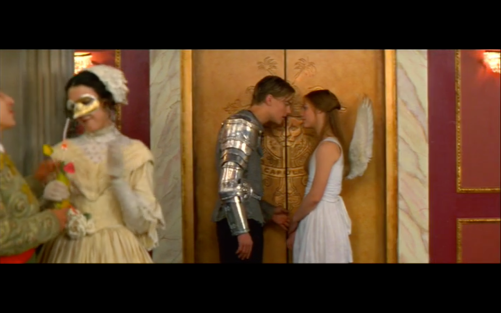
Just as Mercutio turns into a woman for the night, Romeo and Juliet become what they are not as well: a knight with the best of intentions, and an angel with freedom. Furthermore, Johae also cites the behavior of Lady Capulet and Tybalt, writing,
At the party she puts aside decorum (as is fitting at carnival) and behaves as though she is having an affair with her nephew, the much-younger Tybalt (she kisses him openly). Tybalt is dressed as “Lucifer, Prince of Darkness” (Pearce and Luhrmann 29) and sports horns—a sexual vigor which quickly turns into hatred once he sights Montague men (305).

All of these scenes are heightened by the fact that until Romeo encounters Juliet for the first time, he is high out of his mind on “Queen Mab,” an ecstasy tablet, given to him by Mercutio. He hallucinates while at the party, and imagines Mercutio’s big performance, in which he is seen wearing a slightly more intricate outfit and larger wig.

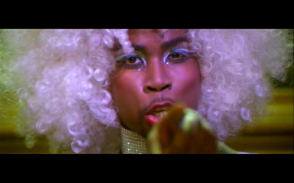
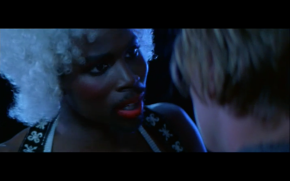

Johae claims that Mercutio’s “cross-dressing” is part of the carnival atmosphere, “where there is no stage, nor a separation of performers from spectators, because ‘everyone communes in the carnival act’” (306). He writes,
Mercutio, the drag queen is “crowned” with a woman’s white wig and “robed” in a white outfit, while in the real world outside of Bacchanalian excess he is a black man who belongs neither to the Hispanic house of Capulet nor to the Caucasian house of Montague—an outsider were it not for his friendship with Romeo—be it platonic or otherwise. He may have been “crowned” drag queen at the Capulet party, but when the party is over he is dragged down by Capulet and Montague hatred. Hence, his last words: “A plague o’ both your houses!” (306).
Going beyond the “carnival” theory, to automatically assume that because Mercutio wears a dress that he wants to be a woman would be incorrect- there is a whole community of gay men, the “drag” community, who dress up and perform as women but have no desire for gender reassignment surgery. This could very much be Mercutio’s case, or it could have nothing to do with a certain sexuality. It could be that he is gender-fluid, or a person who can identify as both genders.
On the assumption that Mercutio is gay, the insinuation of a homoerotic relationship between he and Romeo seems plausible, as Mercutio appears to be jealous when Romeo does not pay attention to him, always sarcastically bringing up Rosaline, the girl he thinks Romeo is still enamored with. There is also the poignant scene where Tybalt makes the comment, “Mercutio, thou art consortest with Romeo?” indicating that the two have a sexual relationship. His words send Mercutio flying at him, drawing his “sword” (really a gun, but the phallic imagery persists). Since the opposite of love is not hate but indifference, Mercutio’s sensitive and defensive reaction to the accusation of homosexuality may indicate that he is gay.
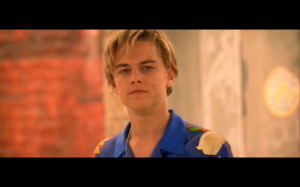
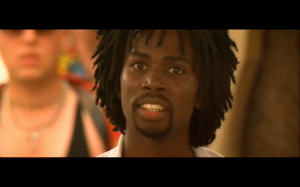
Regardless, what’s interesting is not only Mercutio’s friendship with Romeo, who is unaffected by Mercutio’s outrageous display of femininity, but Mercutio’s relationship with Benvolio and other Montague boys. None seem to display any homophobia towards Mercutio, which may indicate that Mercutio is not queer in any way, shape, or form, or that in Luhrmann’s Verona Beach universe, it is “okay” to be queer, or both. Mercutio does not seem to be judged for his sexuality or gender identity (aside from Tybalt’s comment), which may make the argument of his cross-dressing being carnivalesque rather than transgenderedness obsolete.
Works Cited
Johae, Anthony. “Bahktinian Carnivalesque in Baz Luhrmann’s William Shakespeare’s Romeo + Juliet.” The Explicator 72.4. (2014): 304-307. Academic Search Complete. Web. 6 April 2016.
